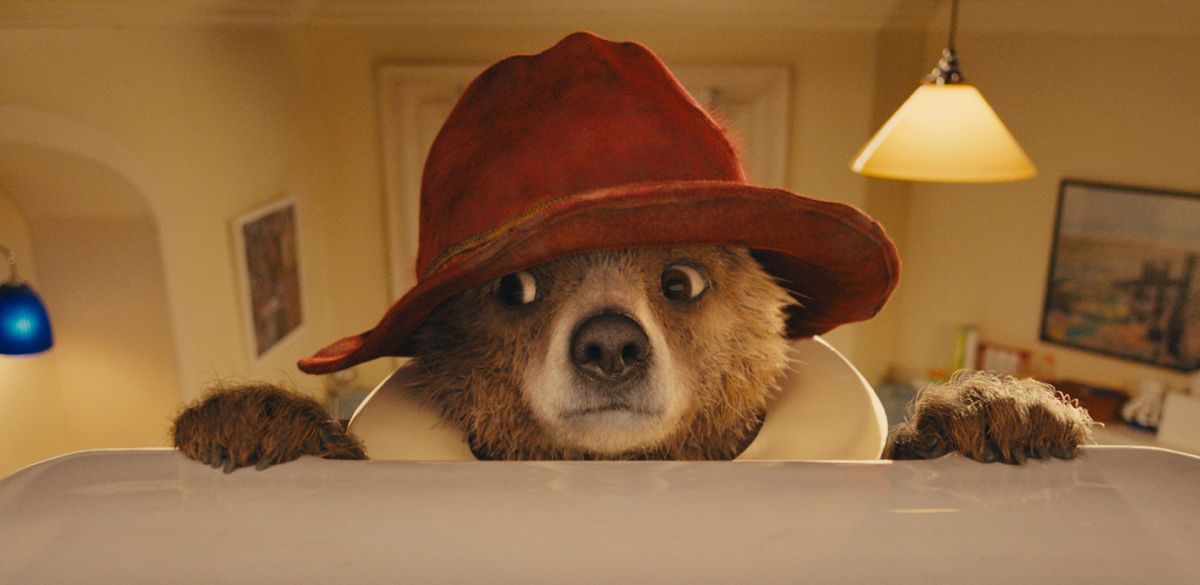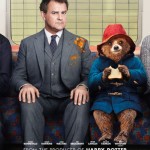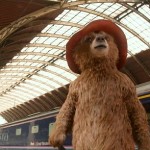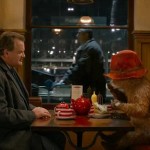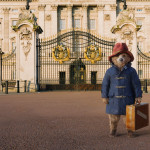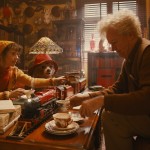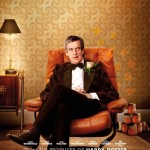That I feel deeply ambivalent about a CGI recreation of the Paddington Bear books by Michael Bond has its roots deep in my childhood. I was given my first Paddington book when I was in hospital, age 10. I consumed it avidly, followed rapidly by all the other books. That the scenario of a talking bear with a penchant for marmalade, wearing a shapeless hat and appearing at a London railway station and being adopted by a family stretched reality beyond snapping point did not seem to matter; the reason for liking Paddington were not hard to fathom – Bond had and has (he is still alive, aged 88) a knack for writing gentle books with wit, charm and humour that extends the appeal of the series well beyond children. There are a few minor disasters but no serious evil, just things to cherish warmly in the cockles of your heart. Many an adult will remember Paddington fondly for these reasons, which made the series an irresistible temptation for film-makers.
This is not the first time Paddington has appeared on screen. There was a 1975 TV series with stop-motion animation, not to mention a 1989 Americanised adaptation. However, the essential nature of any adaptation is this: the further it gets away from its roots, the less likely it is to work, and the imagination of Film Studios is not renowned for sticking with the spirit of its source material.
In the case of the new movie adaptation, called simply Paddington, my early suspicions would be that, like the Magic Roundabout movie and more recently the Postman Pat movie, it would sell our childhoods down the Swannee. The inclusion of a talking bear-stuffing villain in the form of a sadistic museum curator called Millicent, played by Nicole Kidman, who did not feature in the Bond writings did not bode well, since this duel between good and bad is totally alien to the culture of Paddington.
Nor did the counterproductive trailer entice, which made the bear look like a slapstick action hero, surfing on a bath down the stairs, for example. In the original books Paddington does indeed have a problem with the bath (“a bear in hot water”), but that alone is not sufficient for movie makers – they have to gild the lily and overcompensate for the simplicity of the narrative.
In fact, the tendency with this kind of adaptation is always to throw the kitchen sink at it, particularly the actors starring and voicing over the animated characters. After all, score a hit on this stage and you’re made for life if the kids love you. Ms Kidman undoubtedly followed the undeniable truth that baddies are more lovable and memorable than the good guys, and typically get the best lines too.
Anyway, coming back to the point, this adaptation includes not just an A-lister in the form of Ms Kidman but also the ever-splendid Jim Broadbent as friendly junk shop owner Mr Gruber; cheerfully scatty Julie Walters as the cheerfully scatty housekeeper Mrs Bird; Peter Capaldi, aka Doctor Who these days, as grumpy neighbour Mr Curry; and Hugh Bonneville, a man whose facial expression veers along the continuum between looking permanently baffled and anally belligerent, playing actuarial patriarch Mr Brown. Even trendy Matt Lucas gets in on the act in the unlikely role of taxi driver.
But the knack of making a successful animation depends on the unseen vocal talents of those who bring the bunch of pixels to life – and here they are in the safe hands of Michael Gambon, Imelda Staunton and, as the well-spoken and faintly naive bear himself, the well-spoken, trendier and relatively youthful Ben Whishaw. Paddington was originally to be voiced by the comparative elder statesman Colin Firth, but Firth’s vocal gravitas was a poor fit for a young bear so he gracefully made way.
How could it possibly go wrong, the producers might well have said to the money men in their elevator pitch? Very easily, had either the graphics or the script failed to come up to scratch. The latter is where so many adaptations fail to deliver, especially when the burning desire to create a plot or even to engage the interest of both younger viewers (those not brought up on the books) or their parents.
So here’s an interesting thing: of our party, three grown-ups, myself included, were pleasantly surprised and enjoyed the movie, but the one teenager in our midst thought it was the worst film he’d ever seen in his life. Even allowing for teenage hyperbole, that’s quite a statement, one deserving of greater scrutiny.
First thing to note is the graphics. CGI can be an intrusive medium in that it’s quite plainly obvious that the characters are not real, but the technology is improving all the time, here to the point where you could quite readily believe the bears to be a stylised version of reality, such is the minute attention to detail. Paddington is almost hyper-real and imbued with a naturalistic charm that leaps off the pages when you read the books – certainly a million miles removed from the early examples of the genre, for which huge credit is due to the computer geeks.
In fact, the whole production applies a cartoonish quality to the stories that fits well with the CGI, with vignettes more reminiscent of TV adverts but which seem strangely apt in this environment. For example, where a sudden downturn in mood is signified by the leaves falling from a painted tree in the Browns’ staircase wall, a trick that will almost certainly appeal to younger viewers by being more akin to fantasy movies. Certainly the tale has also been slyly updated for a modern generation, technology and all, but then you would expect that.
Secondly, and also to the credit of all concerned, the film goes places the book does not by including back-story in Peru involving Paddington’s aunt and uncle, their discovery by a British explorer, who educates them and encourages them to develop a taste for marmalade. The destruction of their habitat by an earthquake and Paddington’s subsequent stowage to London also add depth and credence to the tale. Perhaps most pertinent is the fact that this background links directly to the character of Millicent and her motives for wanting to capture and stuff Paddington, thus adding credence and coherence where artifice and hackneyed plot devices are usually to be found. It’s quite evident that some thought had gone into the writing of the movie, more than you would usually expect from an attempt to fob off the punters with an easy pre-Christmas sell.
Also worthy of note is that new life has been breathed into the characters, all the more remarkable given their relatively short screen life. They grow, develop, learn, admit their mistakes, become heroes where once they had shied away from adventures. More than that, they gain three dimensions and characteristics that remain hidden from the books, often for good reasons. Did you know Mrs Bird could drink a man under the table? Or that Mr Curry had a secret passion for a dominant woman? Or the longing and frustration buried deep within the Browns’ marriage? Or the teenage angst suffered by young Judy? No, of course you didn’t – they were not in the book, but are very plausible and helpful insights. All these and more are woven into the movie and make the fictional characters seem much more like flesh and blood.
The bear himself bears all the accident-prone hallmarks of the fictional character, but has hit the screen in a naively sympathetic fashion – a fiendishly difficult balancing act to pull off, since in many hands the would have become impossibly mawkish and sentimental. Luckily the ladling of schmaltz is not at hand, so the bittersweet undercurrent rings true.
Maybe the fact that director Paul King and writer David Heyman are British and therefore possessing of an intimate insider view of British emotions and reactions makes a difference, since this is the innate character of Bond’s books – British people coping with unusual scenarios and minor calamities calmly and with only the merest hint of histrionics, which is probably why Millicent and her evil scheming did not fit within the original vision of Paddington’s adopted London world. Whether London has ever been so empty is another question best left unanswered.
In the books everything but the bear is rooted in solid reality, but here there are some high-jinx up at London’s Natural History Museum, not to mention an airborne bear inadvertently catching a pickpocket in West London, oh and the odd trifle with a bath and a skateboard. But then you have to have some stunt interludes to keep minds young and old occupied, don’t you?
Do you? Well anyway, let me say this: of its type, Paddington is certainly one of the best, so thanks go to Heyman’s funny and artful script, without which you could have had all the animated bears imaginable and still failed to ignite audience sympathies. The ingredients are in place for a sequel, natch, in keeping with the film industry’s desire to milk a character and situation for as long as it remains a sure-fire box office winner. My view is that any movies must stay true to the spirit of the original, and in this respect a bullseye has been struck, for sure.
All of which being the case, why, you might reasonably ask, did my son take such a violent reaction from the movie? Association with kids’s books for a burgeoning adult mind, maybe? Perhaps easier to say this movie will not please everyone, but most, like 75% of my party, will be pleasantly surprised, adult and child alike. And the 5-6 year bracket appear to love it!

